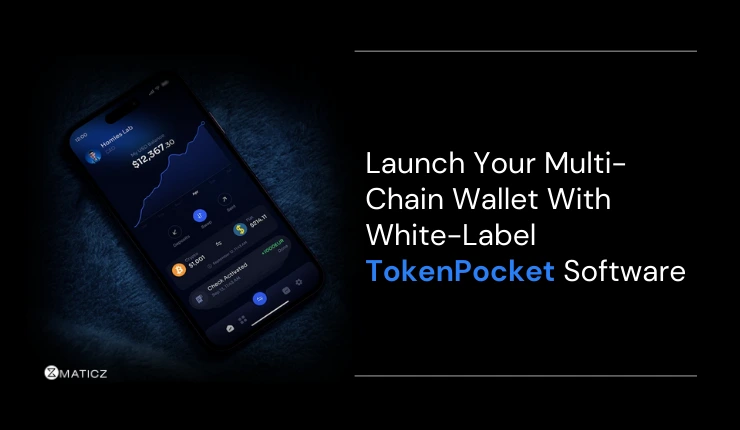Share Posts

The Evolution of Crypto Wallets in the Web3 Era - A Deep Dive
46
1254
103
Digital evolution has placed a remarkable trend shift from the traditional way of handling your digital assets to the upgraded version of an innovative Web3-powered wallet. Initially, crypto wallets act as a transacting cryptocurrency, and some familiar crypto tokens all come under one centralized platform to control them. But with now advent of numerous blockchains, and for handling multifarious digital assets like Cryptocurrencies, non-fungible tokens (NFTs), and some decentralized apps like decentralized finance (DeFi) protocols and play-to-earn games, these kinds of assets directly interact with these web3-supported crypto wallets.
Web3 gives a realm of user-controlled internet built on blockchain the way removes intermediaries such as banks, tech giants, and central authorities will minimizing. Significantly, a crypto wallet acts as a digital asset manager and digital identity hub. So let’s see how crypto wallets evolved and meet the user demands of Web3.
The Evolution of Crypto Wallets
Cryptowallets have undergone significant changes since the early days of blockchain, adapting to the growing complexity and diversity of decentralized ecosystems. Let’s seek the generational changes of crypto wallet evolutions.
First Generation (2011–2015): Basic Crypto Storage
In that period, the BTC average price range is from $5 to $600, which is primarily for storing and transferring bitcoins. At that time, a crypto wallet is often used with command-line interfaces, requiring you to have some technical knowledge to access it. Also, sending bitcoin is a complex process and may occur in error while resulting that the way you permanent loss of funds. In that period, dApps and NFT concepts didn’t yet exist. That was the time when security was a major concern, along with a limited level of user-friendly options in crypto wallets.
Second Generation (2016–2021): Multi-Chain Support and dApp Integration
In 2015, Ethereum introduced its smart contract concept, expanding the potential of blockchain beyond using it for transaction purposes. Over the period, crypto wallet supports various blockchains and integrate with dApps, permitting users to interact with defi protocols, NFT marketplaces and etc. In the meantime, MetaMask launched, and their breakthrough offerings like browser extensions, mobile apps like Android and iOS, and also use on the web that these possibilities users to browse dApps as traditional websites easily. In this trend shift toward broader functionality, though, challenges like managing seed phrases and understanding gas fees persisted.
Current Generation (2022–Present): Smart Wallets with Account Abstraction
Currently, we’re using a crypto wallet that has leveraged advanced technologies like account abstraction to enhance user experience and security. In trend, smart wallets managed by programmable smart contracts to avails features like social recovery, batched transactions, and set your spending limits. These advancements have gone through more paint than previous generations. From that, developing crypto wallets is more accessible and secure for both novice and experienced users.
Here’s we give a tabulation of an overview of the path traversed by crypto wallet evolution
| Generation | Time | Key Features | Challenges | Examples |
First (2011–2015) | Basic crypto storage | Command-line interfaces, Bitcoin-focused | High technical barrier, risk of fund loss | Early Bitcoin wallets |
Second (2016–2021) | Multi-chain support, dApp integration | Browser extensions, smart contract interaction | Complex seed phrases, gas fee confusion | MetaMask, Trust Wallet |
Current (2022–Present) | Smart wallets, account abstraction | Social recovery, programmable features | Adoption of new standards, developer complexity | Safe, Argent |
What is Account Abstraction?
Account Abstraction is one of the evolutions in crypto wallet development, particularly using Ethereum standards like ERC-4337 and EIP-7702 implemented with Ethereum’s Pectra upgrade in 2025. Earlier, Ethereum distinguished between externally owned accounts (EOAs) that are controlled by private keys and contract accounts controlled only through code. Account abstraction differs from this traditional concept, thereby permitting crypto wallets to function as programmable smart contracts. This way, you’ll get a wide range of innovative features.
Gas Free Transactions
Users can make their transactions without holding native cryptocurrencies for gas fees; instead of you can pay in stablecoins or sponsored by third parties like Paymasters.
Social Recovery
Completely relying on seed phrases that can be lost or stolen. Instead of users can add their trusted contacts to help with their wallet account recoveries.
Multi-Signature and Spending Limits
By this methodology, a wallet requires multiple approvals for transactions that enhance overall security for shared wallets or high-value accounts. Also, without the need for any additional approvals, you can program your spending above a certain threshold.
Batched Transactions
Multiple operations can be combined into a single transaction, reducing your gas costs and simplifying the user experience. For example, a user can approve and execute their trade in a single click (approving a token and swapping it on a DEX) rather than splitting two different transactions.
Customizable Transaction Logic
In Crypto wallets, you can set pre-defined rules such as recurring payments, locked transactions, and monthly conditional transfers.
Improved Security
Programmable logic allows for advanced security features, such as freezing accounts, whitelisting trusted dApps, or detecting suspicious activity to block transactions and prevent scammers.
Current Trends in Web3 Wallets
Web3 wallets are robust and cutting-edge features to elevate the wallet's usability, security, and integration with decentralized ecosystems. Here’s what we list out the trends.
Multi-Chain Support
Overall blockchain ecosystem grows with the help of other blockchain adaptations into the crypto wallet. In that way, a crypto wallet is adapting to multiple chains like Ethereum, Solana, and Binance Smart Chain. In some examples of crypto wallets that support various blockchain networks, like Trust Wallet supports 100+ blockchains, and Exodus handles more than 260.
Enhanced Security
Security remains a top priority for multi-chain crypto wallets, with some innovative features like Multi-Party Computation (MPC) and Zero-Knowledge Proofs (ZKPs). MPC-powered wallet offers keyless recovery that is seen in Zengo. On the other hand, ZKPs improve user privacy.
DeFi and NFT Integration
Now, market-available multi-chain wallets are merely authorized to integrate with its platforms like DeFi and NFTs, which facilitate staking and NFT asset management. For instance, Trust Wallet supports over 4.5 million assets and offers in-app swapping and staking.
Social Logins
Ideally, attract a mainstream audience and a newbie to their platform. Crypto wallets support social logins paired with ZKPs for privacy. Here’s the list of some wallets that support social logins for their users, such as Coinbase Wallet, Privy, Particle, and MetaMask.
Built-in Risk Management
Wallets are adding protective user features such as scam detection, protection against Miner Extractable Value (MEV), and transaction simulations to preview outcomes. Tools like Trust Wallet’s Security Scanner and MetaMask’s Smart Transactions protect users from scams and maximal extractable value (MEV) exploits.
AI and Automation
AI takes place everywhere in that respect in crypto wallet support, automated tools and bots for tax reporting, and is emerging to improve user experience and help with regulatory compliance.
Conclusion
The growth of crypto wallets is a broader way, starting from storage to a multifaceted platform, until the web3 phase. As wallets continue to integrate with DeFi, NFTs, and emerging technologies, they are set to play a pivotal role in shaping the future of digital interactions. Crypto wallets aren’t only enhancing people’s web3 usage experience, beyond they it paved the way for the user-centric internet in the decentralization world. In that evolution race, be insistent on your business to turn ideas into a profitable one. Then, Maticz, a leading cryptocurrency wallet development company, will be the best choice to kickstart your business venture with innovative technologies and advanced features that keep your business unique in the market.
Tap Into the Future
The latest insights, posts, and project updates - straight to your inbox.




